全英文高中英语教案
- 格式:ppt
- 大小:1.31 MB
- 文档页数:21
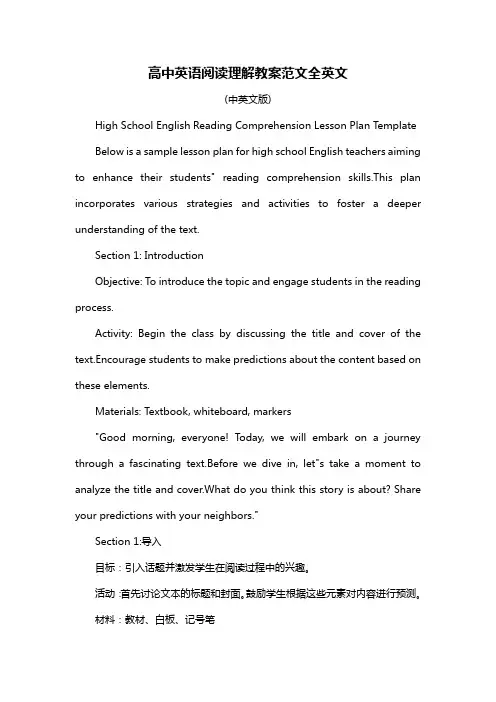
高中英语阅读理解教案范文全英文(中英文版)High School English Reading Comprehension Lesson Plan Template Below is a sample lesson plan for high school English teachers aiming to enhance their students" reading comprehension skills.This plan incorporates various strategies and activities to foster a deeper understanding of the text.Section 1: IntroductionObjective: To introduce the topic and engage students in the reading process.Activity: Begin the class by discussing the title and cover of the text.Encourage students to make predictions about the content based on these elements.Materials: Textbook, whiteboard, markers"Good morning, everyone! Today, we will embark on a journey through a fascinating text.Before we dive in, let"s take a moment to analyze the title and cover.What do you think this story is about? Share your predictions with your neighbors."Section 1:导入目标:引入话题并激发学生在阅读过程中的兴趣。
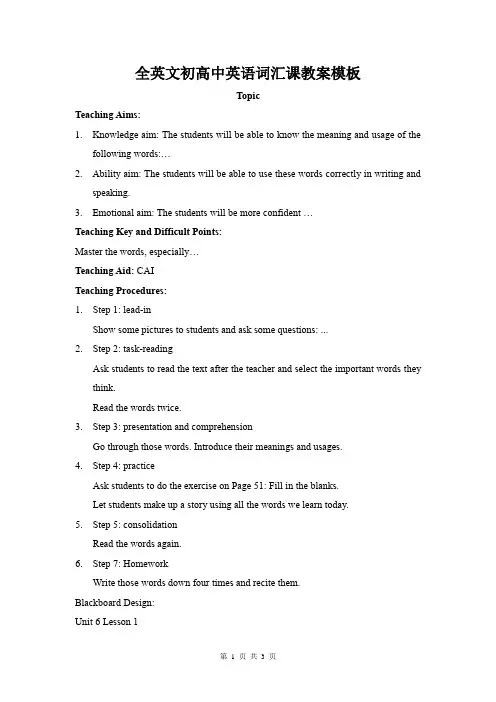
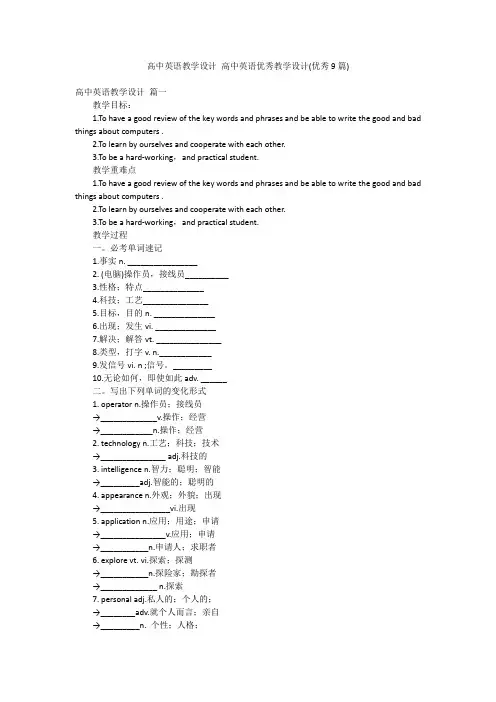
高中英语教学设计高中英语优秀教学设计(优秀9篇)高中英语教学设计篇一教学目标:1.To have a good review of the key words and phrases and be able to write the good and bad things about computers .2.To learn by ourselves and cooperate with each other.3.To be a hard-working,and practical student.教学重难点1.To have a good review of the key words and phrases and be able to write the good and bad things about computers .2.To learn by ourselves and cooperate with each other.3.To be a hard-working,and practical student.教学过程一。
必考单词速记1.事实n. ________________2. (电脑)操作员,接线员__________3.性格;特点______________4.科技;工艺_______________5.目标,目的n. ______________6.出现;发生vi. ______________7.解决;解答vt. _______________8.类型,打字v. n.____________9.发信号vi. n ;信号。
_________10.无论如何,即使如此adv. ______二。
写出下列单词的变化形式1. operator n.操作员;接线员→_____________v.操作;经营→____________n.操作;经营2. technology n.工艺;科技;技术→_______________ adj.科技的3. intelligence n.智力;聪明;智能→_________adj.智能的;聪明的4. appearance n.外观;外貌;出现→________________vi.出现5. application n.应用;用途;申请→_______________v.应用;申请→___________n.申请人;求职者6. explore vt. vi.探索;探测→___________n.探险家;勘探者→_____________ n.探索7. personal adj.私人的;个人的;→________adv.就个人而言;亲自→_________n. 个性;人格;三、用所给词的适当形式填空(1)Can you say dolphins are much more ____________than other animals?Well, they are animals of high _____________. (intelligent)(2) She expressed her _________ opinion yesterday. ____________ speaking, I agreed with what she said. (personal)(3) Any ___________ who would like to _____________ to become anassistant in our company should send us an ___________ .(apply)四、语境助记——词不离句,句不离段With the electronic technology revolution going on,simplified calculation is solved in the application on finance by universal exploration. Our goal of making life happier is certain to be realized through man's intelligence.五、翻译下列必背短语?1.在某种程度上_______________2.依…看;据…认为_____________3.从…时候起_______________4.结果_______________5.处理;安排;对付____________6.弥补,补足;整理,编造_________7.毕竟_______________?8.看守,监视_______________9.在……帮助下_______________?六。
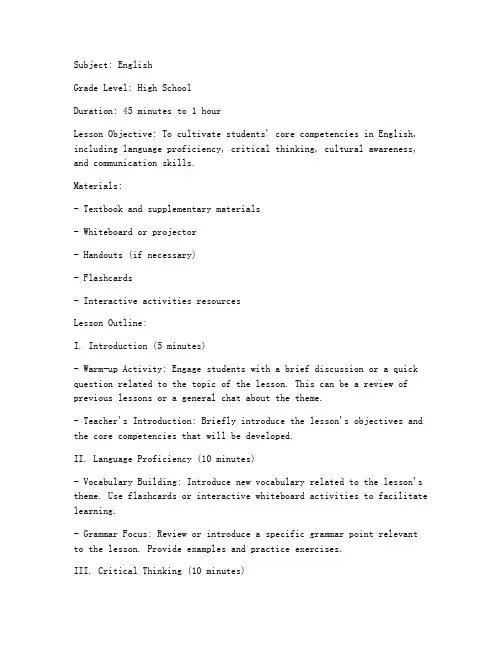
Subject: EnglishGrade Level: High SchoolDuration: 45 minutes to 1 hourLesson Objective: To cultivate students' core competencies in English, including language proficiency, critical thinking, cultural awareness, and communication skills.Materials:- Textbook and supplementary materials- Whiteboard or projector- Handouts (if necessary)- Flashcards- Interactive activities resourcesLesson Outline:I. Introduction (5 minutes)- Warm-up Activity: Engage students with a brief discussion or a quick question related to the topic of the lesson. This can be a review of previous lessons or a general chat about the theme.- Teacher's Introduction: Briefly introduce the lesson's objectives and the core competencies that will be developed.II. Language Proficiency (10 minutes)- Vocabulary Building: Introduce new vocabulary related to the lesson's theme. Use flashcards or interactive whiteboard activities to facilitate learning.- Grammar Focus: Review or introduce a specific grammar point relevant to the lesson. Provide examples and practice exercises.III. Critical Thinking (10 minutes)- Discussion Questions: Pose thought-provoking questions that encourage students to think critically about the topic. Facilitate a class discussion to explore different perspectives.- Critical Reading: Provide a passage or text that requires students to analyze and evaluate the content. Guide them through the process of critical reading.IV. Cultural Awareness (10 minutes)- Cultural Context: Introduce cultural aspects related to the lesson's content. Use multimedia resources such as videos, songs, or images to enhance understanding.- Cross-Cultural Communication: Discuss how cultural differences might impact communication and encourage students to consider diverse viewpoints.V. Communication Skills (10 minutes)- Pair Work or Group Activity: Assign an activity that requires students to communicate in English. This could be a role-play, a debate, or a project-based learning task.- Peer Feedback: Encourage students to give each other constructive feedback on their communication skills.VI. Conclusion (5 minutes)- Summarize the Lesson: Recap the main points covered in the lesson and the core competencies that were developed.- Homework Assignment: Assign homework that reinforces the lesson's objectives and provides additional practice opportunities.VII. Assessment- Formative Assessment: Throughout the lesson, observe students' participation, engagement, and performance in various activities.- Summative Assessment: At the end of the lesson or over a series of lessons, evaluate students' overall progress in achieving the lesson objectives.Lesson Plan Example:Lesson Title: "Environmental Protection: A Global Concern"Objective:- To develop students' vocabulary related to environmental issues.- To enhance students' critical thinking skills through analyzing different perspectives on environmental protection.- To foster students' cultural awareness of environmental challenges faced by different countries.- To improve students' communication skills by engaging in a debate on environmental protection.Materials:- Textbook section on environmental issues- Multimedia resources on global environmental challenges- Debate worksheet- Handouts with environmental vocabularyActivities:- Warm-up: Discuss a recent environmental event and ask students what they think about it.- Language Proficiency: Introduce new vocabulary related to environmental issues and provide examples.- Critical Thinking: Divide the class into groups and assign different perspectives on environmental protection. Each group researches their perspective and presents it to the class.- Cultural Awareness: Show a video or slideshow about environmental challenges in various countries and discuss the cultural context.- Communication Skills: Conduct a debate on environmental protection, with one group arguing for strict regulations and the other for a more flexible approach.Homework:- Write a short essay on a specific environmental。
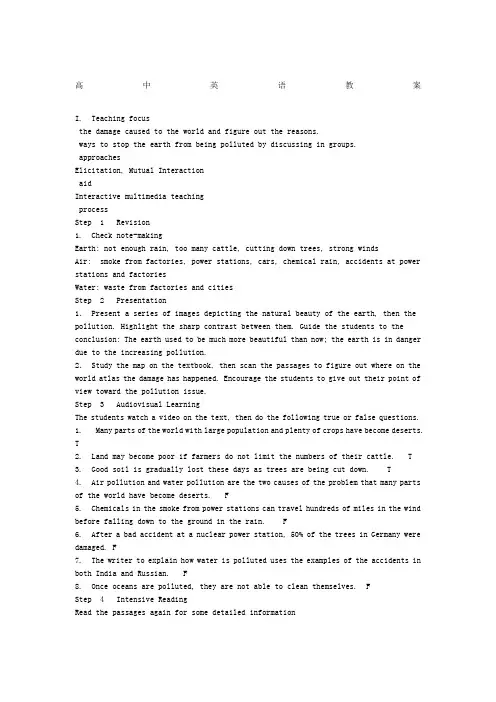
高中英语教案I. Teaching focusthe damage caused to the world and figure out the reasons.ways to stop the earth from being polluted by discussing in groups.approachesElicitation, Mutual InteractionaidInteractive multimedia teachingprocessStep 1 Revision1. Check note-makingEarth: not enough rain, too many cattle, cutting down trees, strong windsAir: smoke from factories, power stations, cars, chemical rain, accidents at power stations and factoriesWater: waste from factories and citiesStep 2 Presentation1. Present a series of images depicting the natural beauty of the earth, then the pollution. Highlight the sharp contrast between them. Guide the students to the conclusion: The earth used to be much more beautiful than now; the earth is in danger due to the increasing pollution.2. Study the map on the textbook, then scan the passages to figure out where on the world atlas the damage has happened. Encourage the students to give out their point of view toward the pollution issue.Step 3 Audiovisual LearningThe students watch a video on the text, then do the following true or false questions. 1. Many parts of the world with large population and plenty of crops have become deserts. T2. Land may become poor if farmers do not limit the numbers of their cattle. T3. Good soil is gradually lost these days as trees are being cut down. T4. Air pollution and water pollution are the two causes of the problem that many partsof the world have become deserts. F5. Chemicals in the smoke from power stations can travel hundreds of miles in the wind before falling down to the ground in the rain. F6. After a bad accident at a nuclear power station, 50% of the trees in Germany were damaged. F7. The writer to explain how water is polluted uses the examples of the accidents in both India and Russian. F8. Once oceans are polluted, they are not able to clean themselves. FStep 4 Intensive ReadingRead the passages again for some detailed information1. To say something about the damage that is caused to the world by pollution, using the information from the text. Try to present possible ways to help solve the problems.PhenomenaCausesSuggestionsEARTHThe area of desert is growing every year.Cattle eat grass.Limit the number of the cattle.Good soil is gradually lost.Trees being cut down; strong winds blowing the valuable soil away.Plant more trees and try to protect them.AIRAir is being polluted.Factories, power stations and cars produce a lot of waste.A lot of things have to be done to reduce pollution. New laws should be passed and people should realize how serious the problem is.A lot of people died from polluted air in both Russia and India.There were serious accidents that polluted the air.Trees in the forest are destroyed and fish in the lakes are killed.Chemical rain.WATERIn some places it’s no longer safe for swimming, nor is it safe to eat the fish. Factories and cities produce a lot of waste.Same as above.Lake Baikal, which used to be cleanest I the world, s now polluted.Waste produced from a chemical factory.summarize the text by giving the main idea of each passage.Earth:The area of desert is growing and good soil is gradually lost.Air:Chemicals in the smoke cause a lot of damage and serious accidents took placefrom time to time.Water:Water pollution is caused by man’s waste. The waters of this great lake have been dirtied and 4800 square km of ocean were polluted by oil.Step 5 DiscussionAppoint one student to host the discussion. The rest of the class fall into groups of 4, changing ideas on the following question.(1)What kind of pollution can you think of(2)Why trees are important(3)What are the causes of water pollution(4) What can be done to stop land from becoming into desert(5) What else do we know about the problems that the earth is facing(6) What steps should we take to save the earthStep 6 Role playThe students take turns to play the role of a newspaper reporter, making interviews with heads of factories . A papermaking factory) which are seriously polluting air and/or water. Record the interviews and compose a report.Step 7 Assignment(1)Read the additional materials about pollution and do the reading comprehension exercises.(2)Finish the report.Thanks for attending this class_____________________________________________________________________________--__资料我国环境污染现状令人担忧据专家估计,中国每年因环境污染造成的损失达到二千八百三十亿元人民币,其中,仅水污染一项,估计一年造成经济损失约五百亿元.据香港东方日报报导,自六十年代至今,中国有环境监测的四百三十二条大小河流中,八成受到不同程度的水体污染,其中大江河经过城镇河段的占二成,支流受污染的占六成,全中国二千八百多个湖泊,凡能接纳城镇污水的,大多出现水体负氧化现象.由于地下水过度开采,京津沪大面积出现土地沉降一点五公尺至二公尺,桂林溶岩区三十米地下水重金属超标十至二十倍.大气污染造成的经济损失约为二百亿元,由于城市燃煤、工厂排放废气及汽车死气污染,大气中二氧化硫、一氧化碳等有毒悬浮微粒弥漫在城市上空,空气污染导致许多城市肺癌死亡率增至万分之二,全国酸雨覆盖面积已达百分之三十,所有这些损失加起来也等于二百亿元.而生态环境破坏和自然灾害造成的损失估计高达二千亿元,森林覆盖率由四九年的三成左右,现已下降至不足一成四,草原的严重退化,水土流失面积达一百五十五万平方公里,占国土面积的百分之十六.同时,城镇建设却仍以每年侵占一百五十万公顷土地的速度发展,破坏自然生态平衡,加上自然灾害带来的损失,每年至少损失二百亿元.其他污染如固体废物排放、噪音污染等造成的损失也高达一百三十亿元.专家分析表示,造成环境污染引起的经济损失原因众多,但国家工业规划布局失误,调控措施不力和公民环保意识不强是主要原因.我的体会;学习了该教案后,我总结体会两点.一、该教案在教学设计上非常注重学生能力的培养,充分利用教材和多媒体手段逐步引导学生理解课文,并能进一步升华课文的主题,使学生受到心灵的启迪和道德的震撼.一切都水到渠成.二、教案所附资料可在课堂中充分被学生利用,使他们的讨论言之有据,会使他们更乐于知识的学习和掌握.这点可以作为我今后很好的借鉴。
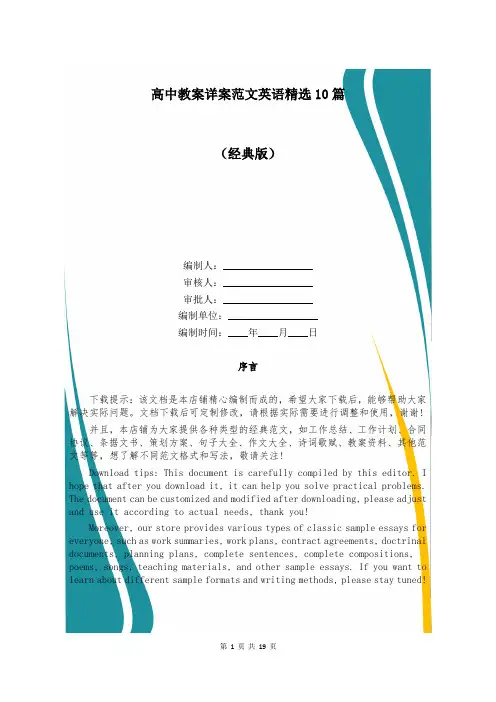
高中教案详案范文英语精选10篇(经典版)编制人:__________________审核人:__________________审批人:__________________编制单位:__________________编制时间:____年____月____日序言下载提示:该文档是本店铺精心编制而成的,希望大家下载后,能够帮助大家解决实际问题。
文档下载后可定制修改,请根据实际需要进行调整和使用,谢谢!并且,本店铺为大家提供各种类型的经典范文,如工作总结、工作计划、合同协议、条据文书、策划方案、句子大全、作文大全、诗词歌赋、教案资料、其他范文等等,想了解不同范文格式和写法,敬请关注!Download tips: This document is carefully compiled by this editor. I hope that after you download it, it can help you solve practical problems. The document can be customized and modified after downloading, please adjust and use it according to actual needs, thank you!Moreover, our store provides various types of classic sample essays for everyone, such as work summaries, work plans, contract agreements, doctrinal documents, planning plans, complete sentences, complete compositions, poems, songs, teaching materials, and other sample essays. If you want to learn about different sample formats and writing methods, please stay tuned!高中教案详案范文英语精选10篇高中教案详案范文英语第一篇I know most of my high school fantasy of XXXcontentXXX is not possible, otherwise it is not called XXXfantasyXXX.Things are always conflict with I XXXthinkXXX, might be gods his old mans house dont let me get it.High school I even very hard tsinghua Beijing university,more dont say XXXones deceased father grindXXX later; The college entrance eXamination after I went to the jiangnan tourism, looking forward to meet in a misty rain.But didnt in this picturesque jiangnan met that my mind think that XXXwomanXXX; Im looking forward to start a company also dont know whether can realize, everything is unknown...高中教案详案范文英语第二篇1.题目:MillenniumKids2.内容Millennium Kids is an international youth empowerment environmental organization.Millennium Kids HQ - Perth Western Australia is a not-for-profit organization headquartered in Perth, Western Australia,began in 1996 after a small group of Western Australian students attended the United Nations ‘Leave It ToUs’ environmental conference for children in the UK.On their return from the conference, the young people were disappointed with the level of youth involvement in local environment issues and decided to set the wheels in motion for developing their own environmental conference –“Kids Helping Kids.With support from Perth Zoo, Department of Environment, Clean Up Australia, CALM and the City of South Perth a conference was born and, subsequently, their own youth-based environmental organization, Millennium Kids Inc.The organization has international affiliates in Canada and South Africa with collaborative organization links in Indonesia and Malaysia.Millennium Kids Australia is a registered charity with taX deductible lennium Kids is run by kids, for kids,aged 10–25 years.A team of educators, mentors and sponsors support their aim to encourage young people to be leaders by being aware and active in their environment.Young people aged 18–25 can progress to leadership and training roles within the organization helping take practical action to improve their local environment.The Millennium Kids agenda is directed by its Youth Board,with fifteen members aged between 10 and 25 years, and issupported by the United Nations Environment Program Agenda 21,Chapter 25 Declaration which states ‘national governments should pay more attention to the opinions and concerns of children regarding the environment’ and how it should be managed for future generations’.3.要求(1)朗读短文(2)设计听力课(3)适当板书设计高中教案详案范文英语第三篇高中英语阅读课文具有题材广泛、体裁各样、语言知识丰富等特征,是各单元教学的核心部分,也是培养学生阅读能力的主要渠道。
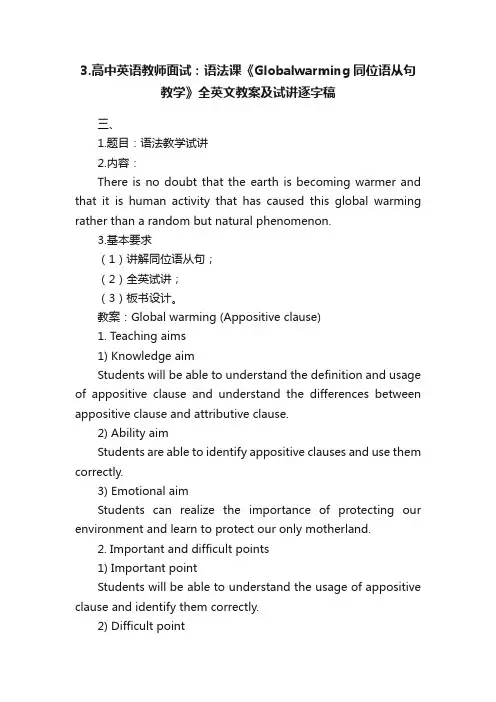
3.高中英语教师面试:语法课《Globalwarming同位语从句教学》全英文教案及试讲逐字稿三、1.题目:语法教学试讲2.内容:There is no doubt that the earth is becoming warmer and that it is human activity that has caused this global warming rather than a random but natural phenomenon.3.基本要求(1)讲解同位语从句;(2)全英试讲;(3)板书设计。
教案:Global warming (Appositive clause)1. Teaching aims1) Knowledge aimStudents will be able to understand the definition and usage of appositive clause and understand the differences between appositive clause and attributive clause.2) Ability aimStudents are able to identify appositive clauses and use them correctly.3) Emotional aimStudents can realize the importance of protecting our environment and learn to protect our only motherland.2. Important and difficult points1) Important pointStudents will be able to understand the usage of appositive clause and identify them correctly.2) Difficult pointStudents will be able to distinguish the differences between appositive clause and attributive clause.3. Teaching and learning methodsSituational teaching method; communicative teaching method; task-based teaching method;group work method; cooperation study method; independent study method4. Teaching proceduresStep 1: Lead inEnjoy a short video clip The earth song by Michael to students to lead to the topic about environmental protection.Step 2: Presentation1) Ask a question: What caused global warming? First, the teacher present the question to students and ask them to find the answer according to the text. Students find the sentence“There is no doubt that the earth is becoming warmer and that it is human activity that has caused this global warming.”2) Ask students to talk about the relationship between the noun “doubt”and that clause. Then introduce the definition of appositive clause to students.3) Present more sentences to students and ask them to find out conjunctions of appositives clause.4) Present two sentences The news that our team has won the match made me excited. &The news that she told me made me excited. to students and ask them to find out which one is appositive clause and which one is attributive clause.5) Summary and supplement. The teacher gives summary and supplements about appositive clause.Step 3: PracticePresent some appositive clauses to students and ask them tochoose the appropriate conjunctions for each appositive clause.Step 4: ProductionAsk students to work in groups of four and design a poster about environment protection. Try to use appositive clause as many as possible. Step 5: Summary and homeworkThe teacher leads students to summarize what they have learned in this class.Homework: Finish the exercises about appositive clause in their text books.5. Blackboard designAppositive clauseThere is no doubt that the earth is becoming warmer and that it is human activity that has caused this global warming rather than a random but natural phenomemon.试讲稿:语法教学(Appositive clause)GreetingHello, boys and girls. I am glad to see you again. Are you happy today? That’s great. I am so happy to hear that.1.Lead inBefore our class, let’s enjoy a video clip The earth song. Now look at the ppt and after you watch it, please tell me what’s the video about. Emm, what’s the video about? Yes, it’s about the environmental problems. So today let’s learn something about it.2.PresentationClass, please look at the handouts, I have a question for you. What caused global warming? Yeah, There is no doubt that the earth is becoming warmer and that it is human activity that has caused this global warming rather than a random but natural phenomemon. You guys got the correct。
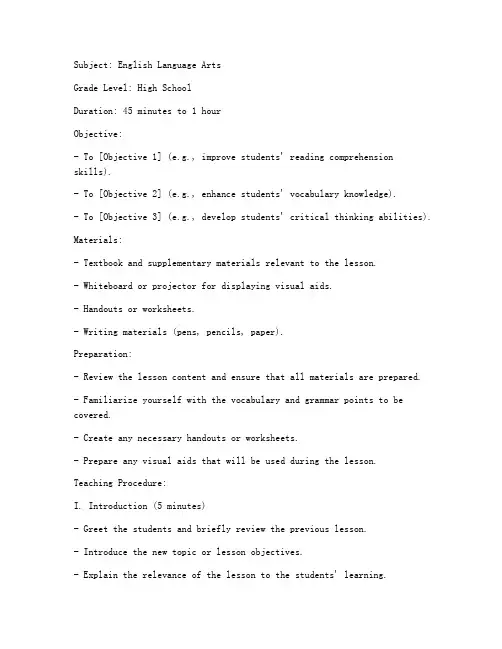
Subject: English Language ArtsGrade Level: High SchoolDuration: 45 minutes to 1 hourObjective:- To [Objective 1] (e.g., improve students' reading comprehension skills).- To [Objective 2] (e.g., enhance students' vocabulary knowledge).- To [Objective 3] (e.g., develop students' critical thinking abilities).Materials:- Textbook and supplementary materials relevant to the lesson.- Whiteboard or projector for displaying visual aids.- Handouts or worksheets.- Writing materials (pens, pencils, paper).Preparation:- Review the lesson content and ensure that all materials are prepared.- Familiarize yourself with the vocabulary and grammar points to be covered.- Create any necessary handouts or worksheets.- Prepare any visual aids that will be used during the lesson.Teaching Procedure:I. Introduction (5 minutes)- Greet the students and briefly review the previous lesson.- Introduce the new topic or lesson objectives.- Explain the relevance of the lesson to the students' learning.II. Warm-Up Activity (10 minutes)- Conduct a brief activity to activate prior knowledge and engage the students.- Example: A quick quiz, a vocabulary game, or a related reading passage.III. Main Content (20 minutes)- Present the main content of the lesson through various activities.- Example:- Reading Comprehension: Have students read a passage and answer comprehension questions.- Vocabulary Building: Introduce new vocabulary and have students practice using them in sentences.- Grammar Practice: Explain and demonstrate the grammar point, then have students practice with exercises.IV. Group Work (10 minutes)- Divide the class into small groups and assign a task related to the lesson.- Example: Discuss a topic, create a presentation, or solve a problem together.V. Individual Work (10 minutes)- Provide students with individual tasks to complete.- Example: Writing a paragraph, filling out a worksheet, or completing a puzzle.VI. Conclusion (5 minutes)- Summarize the main points of the lesson.- Ask students to share their thoughts or experiences related to the topic.- Assign homework or discuss the next lesson.Assessment:- Evaluate students' understanding and participation through quizzes, exercises, and group work.- Collect and review individual work to assess writing and critical thinking skills.Homework:- Assign relevant homework to reinforce the lesson.- Example: Reading a passage, writing a short essay, or completing a grammar exercise.Feedback:- Provide constructive feedback on students' work.- Encourage students to ask questions and seek clarification.Extension Activities:- Suggest additional activities for advanced students or those who need extra help.- Example: Reading a more challenging text, researching a topic, or creating a project.Note:- Adjust the teaching procedure and activities as needed based on the students' needs and responses.- Ensure that all students are engaged and that the lesson is accessible to all learners.---This template can be customized according to the specific needs of the lesson and the level of the students.。
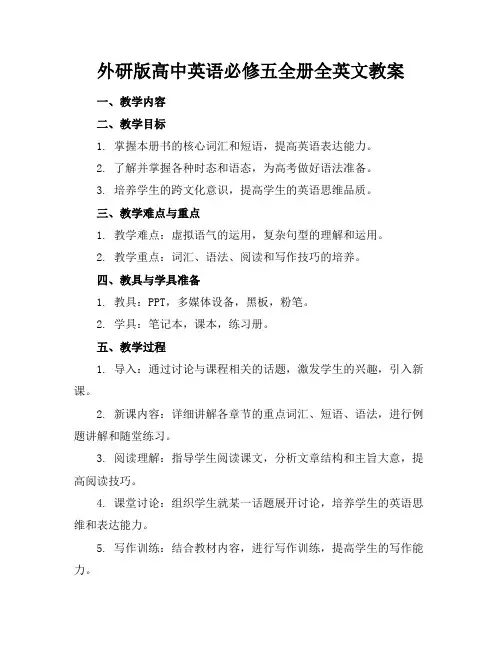
外研版高中英语必修五全册全英文教案一、教学内容二、教学目标1. 掌握本册书的核心词汇和短语,提高英语表达能力。
2. 了解并掌握各种时态和语态,为高考做好语法准备。
3. 培养学生的跨文化意识,提高学生的英语思维品质。
三、教学难点与重点1. 教学难点:虚拟语气的运用,复杂句型的理解和运用。
2. 教学重点:词汇、语法、阅读和写作技巧的培养。
四、教具与学具准备1. 教具:PPT,多媒体设备,黑板,粉笔。
2. 学具:笔记本,课本,练习册。
五、教学过程1. 导入:通过讨论与课程相关的话题,激发学生的兴趣,引入新课。
2. 新课内容:详细讲解各章节的重点词汇、短语、语法,进行例题讲解和随堂练习。
3. 阅读理解:指导学生阅读课文,分析文章结构和主旨大意,提高阅读技巧。
4. 课堂讨论:组织学生就某一话题展开讨论,培养学生的英语思维和表达能力。
5. 写作训练:结合教材内容,进行写作训练,提高学生的写作能力。
六、板书设计1. 核心词汇和短语。
2. 各章节重点语法。
3. 阅读和写作技巧。
七、作业设计1. 作业题目:(1)背诵并默写本节课的核心词汇和短语。
(2)完成课后练习册的相关题目。
(3)根据本节课的话题,写一篇短文,不少于100词。
答案:(1)见课本附录。
(2)见课后练习册。
(3)略。
八、课后反思及拓展延伸1. 反思:关注学生的学习情况,针对学生的薄弱环节进行有针对性的辅导。
2. 拓展延伸:推荐相关阅读材料,提高学生的阅读水平,拓宽知识面。
结合现实生活,让学生用英语表达自己的观点,提高学生的实际运用能力。
重点和难点解析1. 教学难点:虚拟语气的运用,复杂句型的理解和运用。
2. 教学重点:词汇、语法、阅读和写作技巧的培养。
4. 作业设计:作业题目的针对性和答案的详细性。
一、虚拟语气的运用和复杂句型的理解和运用1. 虚拟语气是高中英语教学中的重点和难点,尤其在Lesson 3 The future of cloning中,涉及对未来情况的假设和推测。
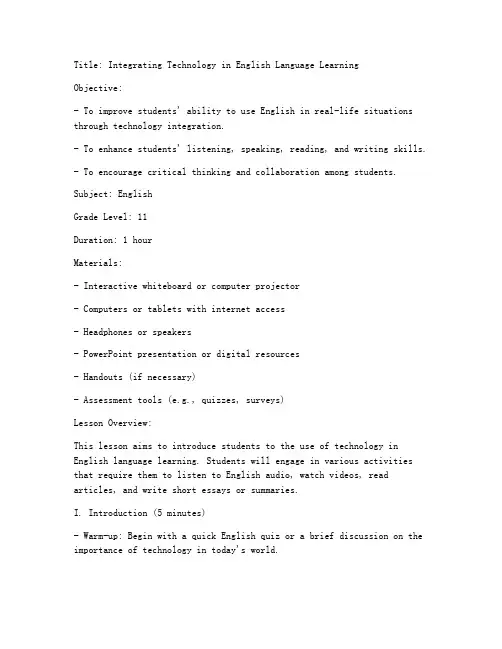
Title: Integrating Technology in English Language LearningObjective:- To improve students' ability to use English in real-life situations through technology integration.- To enhance students' listening, speaking, reading, and writing skills.- To encourage critical thinking and collaboration among students.Subject: EnglishGrade Level: 11Duration: 1 hourMaterials:- Interactive whiteboard or computer projector- Computers or tablets with internet access- Headphones or speakers- PowerPoint presentation or digital resources- Handouts (if necessary)- Assessment tools (e.g., quizzes, surveys)Lesson Overview:This lesson aims to introduce students to the use of technology in English language learning. Students will engage in various activities that require them to listen to English audio, watch videos, read articles, and write short essays or summaries.I. Introduction (5 minutes)- Warm-up: Begin with a quick English quiz or a brief discussion on the importance of technology in today's world.- Introduction: Explain the lesson objectives and how technology will be used to achieve them.II. Listening and Speaking (10 minutes)- Activity: Play a short English podcast or a YouTube video related to the topic of the lesson.- Task: Ask students to summarize the main points of the audio/video in their own words.- Group Work: Divide students into small groups and have them discuss their summaries.- Presentations: Each group presents their summary to the class.III. Reading and Writing (15 minutes)- Activity: Provide students with an article or a series of web pages related to the topic.- Task: Students read the material and answer comprehension questions.- Writing: Ask students to write a short essay or summary based on the reading material.IV. Collaboration and Critical Thinking (10 minutes)- Activity: Assign a project that requires students to use technology to research a topic and present their findings.- Task: Students work in pairs or small groups to complete the project.- Group Work: Each group shares their research and presentation with the class.V. Reflection and Assessment (10 minutes)- Reflection: Have students reflect on what they have learned about using technology in English language learning.- Assessment: Provide feedback on the essays or summaries written during the lesson. Use quizzes or surveys to assess students' understanding of the material.Conclusion:- Summary: Recap the main points of the lesson and reinforce the importance of technology in English language learning.- Homework: Assign a related task that involves using technology, such as watching a YouTube video or reading an article in English.Assessment Criteria:- Listening and Speaking: Ability to summarize audio/video content accurately and express thoughts clearly.- Reading and Writing: Understanding of the material, accuracy of the summary or essay, and use of appropriate vocabulary and grammar.- Collaboration and Critical Thinking: Ability to work effectively in a group, critical analysis of the topic, and creativity in the project.Note: This template can be adapted to different topics and lesson objectives. Ensure that the activities are engaging and relevant to the students' interests and learning styles.。
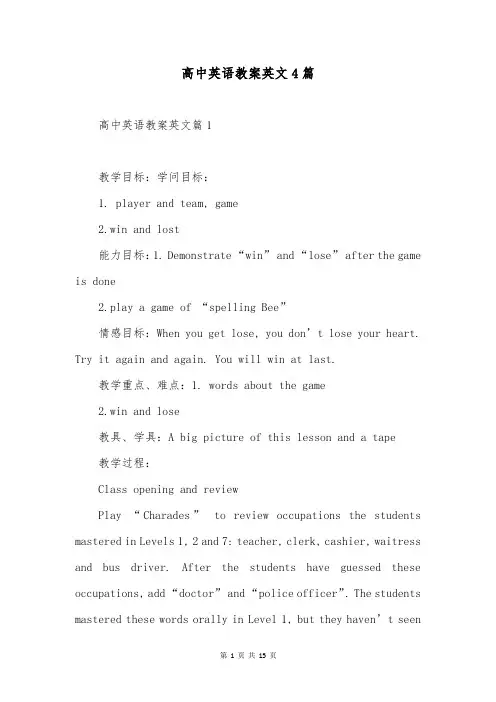
高中英语教案英文4篇高中英语教案英文篇1教学目标:学问目标:1. player and team, game2.win and lost能力目标:1. Demonstrate “win” and “lose” after the game is done2.play a game of “spelling Bee”情感目标:When you get lose, you don’t lose your heart. Try it again and again. You will win at last.教学重点、难点:1. words about the game2.win and lose教具、学具:A big picture of this lesson and a tape教学过程:Class opening and reviewPlay “Charades”to review occupations the students mastered in Levels 1, 2 and 7: teacher, clerk, cashier, waitress and bus driver. After the students have guessed these occupations, add “doctor” and “police officer”. The students mastered these words orally in Level 1, but they haven’t seenthem for a long time. Whisper the translation for these occupations to the students acting them out, and help the class guess the occupations with lots of prompts and encouragement. You can, for example, draw blanks on the blackboard and slowly write in the letters as you soundout more and more of each occupation.IntroduceDemonstrate “player”“team”“game” with six volunteers and a game of “spelling bee” divide the volunteers into two teams of three. Give player a sheet of coloured paper to hold, the same colour for each team.Demonstrate “win” and “lose” after the game is done. Point to the teams and as you say “You win/lose”Use the student bookPause after Number 1 in the student book.Review the story so far. Li Ming and Jenny have been learning about sports. Look at the pictures in the student book. What are they doing now?Note some of the idiom in this lesson: Bob plays basketball “for fun” Jenny and Li Ming “jump up and down” Li Ming asks Jenny “What’s the score?” What do the students think these phrases mean?PracticeDivide the class into small groups. In each group. Some students pretend that they want to learn a game that the other students know how to learn a game that you play in class.Do the activity bookClass closing高中英语教案英文篇2教学目标学问与技能(1)熟练把握下列词汇:rules, arrive, late, hall, dinning hall, listen, , fight, sorry outside,wear, important, bring, uniform, quiet(2)熟练把握下列短语:dining hall, arrive late for school, (be) on time, listen to music break the rules, in class, be/ keep quiet, a lot of, bring …to…,wear a hat, have to, music players(3)把握下列句型:1. Dont eat in class.2. You must be on time.3. Eat in the dining hall.4. 正确使用情态动词can, can’t——Can we wear a hat in school?——Yes, we can./No, we can’t.5. 能正确使用have to 和 must 谈论规章制度We must be on time/ We also have to be quiet in the library.教学重难点重点:1) 确定祈使句是省略掉主语的原形动词开头;2) 否定祈使句则是在确定祈使句前加上“don’t”。
Subject: English Language ArtsGrade Level: Grade 10Lesson Title: [Insert Lesson Title]Objective:- To [state the main objective of the lesson, e.g., improve vocabulary, enhance reading comprehension, practice speaking skills, etc.].- Students will [specifically define what students will be able to do by the end of the lesson].Duration: [Insert total time for the lesson, e.g., 45 minutes]Materials:- Textbook and related resources- Whiteboard or blackboard- Projector and screen (if needed)- Handouts (e.g., vocabulary lists, reading passages)- Writing materials (pens, pencils, paper)- Digital devices (laptops, tablets) for interactive activities (if available)Preparation:- Familiarize yourself with the lesson content and any related resources.- Prepare any handouts or visual aids.- Ensure that technology is functioning properly if using digital resources.- Arrange the classroom to facilitate student engagement and participation.Lesson Procedures:1. Warm-Up (5 minutes)- Start with a brief activity to engage students and review previous learning.- Example: A quick quiz or a short discussion on a previous lesson topic.2. Introduction (5 minutes)- Introduce the lesson topic and its relevance.- Provide a brief overview of the main objectives and activities.- Example: "Today, we will explore the theme of [theme] in [text or topic]. We will focus on [specific skill or concept]."3. Main Activity (20 minutes)- Reading Comprehension:- Present a reading passage or text related to the lesson theme.- Have students read silently or aloud, depending on the text complexity.- Ask comprehension questions to check understanding.- Example: "What is the main idea of the passage? Can you identify the author's tone?"- Vocabulary Building:- Introduce new vocabulary related to the lesson theme.- Use context clues, synonyms, and antonyms to help students understand the words.- Example: "Today's vocabulary words include [list of words]. Let's use them in sentences."- Grammar Practice:- Review or introduce a specific grammar point relevant to the lesson.- Provide examples and exercises for students to practice.- Example: "Today, we will focus on [specific grammar concept]. Let's complete the exercises on page [page number]."- Speaking and Listening:- Engage students in group discussions or partner work to practice speaking and listening skills.- Example: "Work with your partner to discuss how [topic] affects [target audience]."4. Group Work or Individual Assignment (10 minutes)- Divide students into small groups or assign individual tasks to reinforce learning.- Example: "Each group will create a poster summarizing the main points of the reading passage."5. Closure (5 minutes)- Summarize the key points covered in the lesson.- Ask students to reflect on what they have learned.- Example: "What did you find most interesting about today's lesson? What questions do you still have?"6. Homework Assignment (if applicable)- Assign relevant homework to reinforce learning from the lesson.- Example: "Read the next chapter of the textbook and answer the comprehension questions on page [page number]."Assessment:- Evaluate student participation and understanding through quizzes, class discussions, and homework assignments.- Example: "Students will be assessed on their ability to identify and use new vocabulary, answer comprehension questions, and participate in class discussions."Reflection:- After the lesson, reflect on what worked well and what could be improved for future lessons.- Example: "Students seemed to enjoy the group discussions。
高中英语优秀教案(优秀7篇)高中英语教学设计篇一知识目标:复习两个阅读技能——scanning,skimming;学习本单元的部分生词。
本事目标:能构成文章的图式,在图式的帮忙下自主地复述本课的主要资料,在此过程中实现生词的重现。
情感目标:学生在教师的启发下,经过师生互动和生生互动,进一步探究知识。
在这一过程中,学生能够不断地实现互相教育和自我教育,并能寻求自我发展;学生能明白计划的重要性,并能收获一些与之相关的谚语。
教学重难点构成文章的`图式,并在图式的帮忙下复述文章的主要资料。
教学工具课件教学过程StepsTeacher’s activityStudents’ activityAimsStep 1Show and tell the students the learning goals for them and make possible explanationsStudents listen to the teacher and have an idea of what they are going to learn in this class。
To make the students know what they are to learn in this classStep 21)、Show some pictures with beautiful scenery2) Ask the students two questions:Are they attractive?Where do you want to travel? – I dream about traveling…1)Students appreciate those pictures2) Students answer teacher’s questions and practice the sentence pattern “I dream about traveling into…”1) To arouse students’ interest2) To practice a sentence patternStep 31) Show the title of the reading passage2) Ask the students whether this passage is about the whole process of the journey。